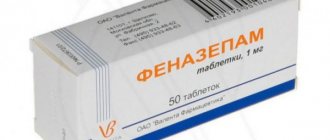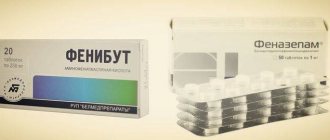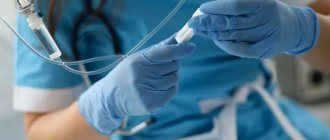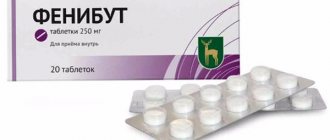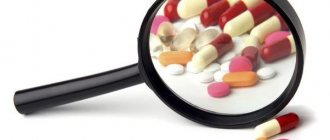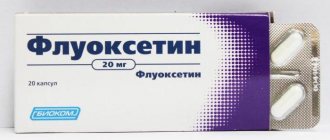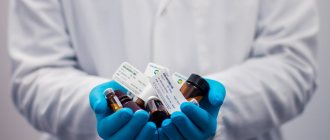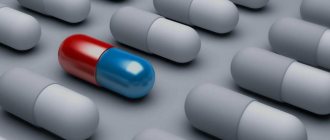- General information
- Historical facts
- Effect on the body
- How to recognize a drug addict
- Tests for Phenazepam
- How long does it stay in the body?
- How long do drug addicts live?
- Analogs
- How to speed up elimination at home
- Detoxification in hospital
- Perdose
- How to recognize and what to do
- Rehabilitation
- Coding
- Why you can’t undergo rehabilitation at home or on an outpatient basis
- Resocialization and work with codependents
- How to quit on your own
Attention! Drug use causes irreparable harm to health and poses a danger to life!
General information
The drug phenazepam is a typical tranquilizer. It is used to normalize sleep, combat anxiety, and relieve convulsive syndrome in epilepsy. Fenozepam is available in injection form or in tablets. All central effects of the drug are achieved through stimulation of benzodiazepine receptors.
The effect of the drug extends to the reticular formation, nonspecific centers of the thalamus and the amygdala complex. The muscle relaxant effect is based on the ability to block spinal reflexes. The tranquilizer is well absorbed through the gastrointestinal tract, after which it is metabolized in the liver and excreted by the kidneys.
Phenazepam is available without a prescription. Doctors sometimes prescribe it to improve sleep, relieve anxiety during performances or in extreme situations. The first aid kit always contains Phenazepam in injection form to relieve seizures in epilepsy or damage to the central nervous system.
All drugs from the benzoidazepine group cause sleep lasting up to 6-8 hours. But the longer the sleep, the stronger the drowsiness, fatigue and depression will be during the next day after taking the drug.
Taken from: Pharmacology, tenth edition by D.A. Kharkevich
The drug is not considered a drug, but addiction can develop from it. In addition, with each subsequent dose, to achieve the desired effect, it is necessary to increase the dose. If you increase the dosage without consulting a doctor, this will lead to acute drug poisoning with possible death.
Contraindications to the use of Phenazepam
Taking the drug is not indicated for everyone. You should avoid using the medicine:
- In case of hypersensitivity to the active component or additional components of the drug, as well as to other drugs included in the benzodiazepine group.
- In acute attacks of angle-closure glaucoma or predisposition to the development of the disease. Taking the drug can cause complete loss of vision. And this process will become irreversible.
- With the development of myasthenia gravis. A feature of this neuromuscular disease is rapid fatigue of skeletal muscles.
- In case of acute poisoning with alcoholic drinks, sleeping pills or narcotic drugs.
- Pregnant women, especially in the early stages. The active component penetrates the placenta, causing a toxic effect on the fetus. This can cause severe birth defects. Nursing mothers should also refuse to take it.
The drug is not prescribed to patients in a state of shock and coma. Its use is not recommended for people suffering from severe depression with suicidal tendencies.
Phenazepam is not prescribed to children and adolescents under 18 years of age.
The drug is prescribed to patients only on the recommendation of a doctor and under his supervision:
- With renal or liver failure.
- With acute psychosis.
- With ataxia. The pathology is characterized by a violation of the coordination of movements of different muscle groups in the absence of muscle weakness.
- With sensory impairment or motor function disorders.
- Low protein in the blood.
- In the presence of tumor processes in the brain.
- Having a tendency to drug addiction.
- Suffering from apnea syndrome.
READ Magnesium overdose
The drug causes a decrease in concentration and slows down reactions, so its use is prohibited for people whose activities involve driving a car or other complex mechanisms.
Historical facts
The drug was invented in the 1970s. The developers who received the state order for the new medicine were the scientific directors of the departments of pharmacology from the Odessa Institute of Physics and Chemistry. After successful research and launch of the drug on the market, the group of voters received the USSR State Prize.
The peak use of the drug came at the end of the 80s, when facts of abuse of barbiturates were published and proven. Phenazepam and its analogues have become alternative drugs with similar effects but fewer adverse reactions.
Let's summarize
Unfortunately, you can die from Phenazepam if you do not follow your doctor's recommendations. The use of the drug will not lead to death unless you increase the dose yourself and do not mix the drug with substances that mutually enhance the effect of the drug. Remember that only 10 mg of the active substance of the drug per day is the minimum lethal dosage. If you listen to your doctor, it will be impossible to die from Phenazepam. Don't self-medicate!
Found a mistake? Select it and press Ctrl + Enter
Fenozipam is a benzodiazepine tranquilizer, a medication prescribed by a doctor for various illnesses. Increasing the dosage of the medication on your own can lead to dire consequences. Phenazepam poisoning (ICD-10 code T42.4) is a common occurrence in the practice of resuscitators, narcologists, and local doctors.
Effect on the body
After the drug binds to benzodiazepine receptors and the reticular formation, the patient becomes calm and anxiety is eliminated. Then drowsiness appears, smoothly turning into sleep. In addition, the effect of the drug on limbic structures, reflex connections and the thalamus leads to the fact that the drug has the following effects:
- reduces feelings of fear;
- relieves irritability;
- increases emotional lability;
- reduces the manifestation of phobias;
- relieves alcohol and drug withdrawal syndrome;
- relieves muscle spasms;
- prevents nervous tics.
But you should be careful when using Phenazepam. It has a pronounced toxic effect on the liver and heart. If this tranquilizer is abused, the following disorders may occur:
- increased drowsiness, feeling tired;
- nausea and vomiting;
- dizziness;
- fast fatiguability;
- hematopoietic disorders (leukopenia, thrombopenia);
- urinary retention or incontinence;
- epileptic seizures;
- visual impairment;
- depression;
- constipation or diarrhea;
- increased activity of liver enzymes, jaundice;
- dysmenorrhea;
- hallucinations.
To achieve a narcotic effect, Phenazepam is not used in isolation. More often it is combined with other drugs to enhance the result. When the pharmaceutical dose is increased by 2-4 times, the patient's condition becomes the same as with alcohol intoxication or an overdose of barbiturates. But the negative effects and disruption of internal organs are tens of times stronger.
At the moment, benzodiazepanes are the most adequate means to combat insomnia, which is caused by emotional tension, stress, anxiety and worry.
Taken from: Pharmacology, tenth edition by D.A. Kharkevich
Symptoms of poisoning
At all stages of poisoning, respiratory functions are impaired, respiratory failure due to tongue retraction becomes more complicated, the intensity of salivation increases, and mucus in the lungs is formed much more intensely.
Complications in the functioning of the cardiovascular system are also observed at all stages of the poisoning process. The heart muscle is often subject to toxic dystrophy. In total, there are several stages of Phenazepam overdose.
Mild poisoning
This is the primary stage. Under the influence of Phenazepam, clouding of consciousness is possible, deep sleep occurs, the patient is in a state of drug intoxication, and hearing problems arise.
In this case, nystagmus, ptosis develops, and convergence disorder occurs. At the first stage, tendon reflexes worsen, muscle tissues become hypotensive, the pupils react normally to light, and cerebellar ataxia often occurs. The patient has normal contact with others.
Moderate poisoning
In the second stage, the pupils stop responding to the light source and become narrow. The corneal and tendon reflexes deteriorate significantly, the cough reflex stops functioning, swallowing becomes difficult, and the patient often falls into a state of superficial coma.
Severe intoxication
At the third stage, the patient develops agony, no reflexes are observed, painful effects do not cause a reaction, and the teenager always falls into a state of severe coma.
There is a pathological enlargement of the pupils or mydriasis. Impaired respiratory functions are recorded, blood pressure decreases, and the likelihood of developing tachycardia and hypothermia increases.
Chronic poisoning
In case of chronic poisoning with Phenazepam, symptoms such as tremor, anxiety, weakness of the body, deterioration of sleep, nausea, and vomiting may occur over time; patients often complain of abdominal pain.
With an increased likelihood of developing convulsions, hallucinations, increased agitation and hyperthermia, death is quite possible.
The lethal dose of Phenazepam for adults is 0.5 mg/kg (that is, for a 50-kilogram girl this would be 50 tablets, just one standard package), for children this dose is less - 0.25 mg/kg.
The development of central disorders is highly likely to be observed after recovery.
How to recognize a drug addict
As with any addiction, a drug addict can be in two states: the effects of the drug and the state of withdrawal. In the first case, the patient will be sleepy, lethargic, and answer questions slowly. A person can sleep for a long time. Drug addicts under the influence of Phenazepam react inadequately to external stimuli, they have an increased pain threshold, impaired breathing and a slow heartbeat.
The picture resembles intoxication with alcohol, but there is no smell or bottles of alcohol. But near such a drug addict you can find various packages of medicines and empty packages of pills.
In the case of withdrawal, the opposite is true. The peculiarity of taking tranquilizers is that they cannot be abruptly stopped. If a drug addict runs out of a new dose of medication, he will suffer from insomnia and his general condition will be anxious. Nervous tics will appear, the addict will move into the aggressive phase. When searching for a dose, such a person can deceive those closest to him, sometimes even hit them.
It is difficult to reliably recognize that a person is dependent on tranquilizers. Therefore, the best way to determine drug addiction is testing. Only in this way can you either confirm or eliminate your suspicions.
How to avoid poisoning?
Doctors recommend caution when taking Phenazepam. It is not recommended to leave tablets in an open space accessible to children. Under no circumstances should such a remedy be taken independently without the prior recommendation of the attending physician.
You should always take into account the prohibition of drinking alcohol and other alcohol-containing liquids with Phenazepam. In case of poisoning, you must try to provoke a gag reflex and seek help from a qualified doctor. Such medications are absorbed quite quickly. The maximum permissible dosage, in accordance with the instructions, should be 0.01 g.
The drug is absorbed quite quickly in the body, due to the peculiarities of its chemical composition and (lipophilicity) similarity to organic matter. It is for this reason that the drug is remarkably distributed in muscle tissue, passing well through various barriers, including the placental one.
As stated earlier, it is generally not recommended for children under the age of majority to take the drug if they have been diagnosed with an airway disorder such as COPD, or angle-closure glaucoma. To avoid side effects or any symptoms of poisoning, it is recommended to strictly adhere to the advice of your doctor.
Tests for Phenazepam
You can check for the presence of benzodiazepines in the body using a conventional rapid test. The cost of these tests is from 40 to 100 rubles. Urine is tested at home; blood testing is carried out only in laboratories.
Please note that the effect of phenazepam is similar to other narcotic substances, therefore, in parallel with the test for benzodiazepines, a rapid test is carried out using a tablet for 10 drugs. This allows you to quickly check traces of narcotic substances and, if necessary, request laboratory confirmation.
Laboratory confirmation must be done if a person committed an offense under the influence of a drug. The results of rapid tests have no legal force.
To study biomaterials of a drug addict, methods of enzyme immunoassay, gas chromatography-mass spectrometry or gas-liquid spectrometry are used. These methods are written down in the relevant decrees, and can be used in court as a confirmed diagnostic method.
Phenazepam is quickly eliminated from the body through the kidneys, so it is important to know how much time has passed since the last use of the drug.
Please note that there is no specific test for Phenazepam. There is a test for benzodiazepines. If the patient took any drug from the benzodiazepine group (including Phenazepam), the result will be positive.
Application and permissible dose
Phenazepam, as a medicine, is used by modern medicine in the following clinical cases:
- Psychosis and panic attacks , accompanied by feelings of anxiety and fear;
- Neurotic, neurosis-like, psychopath-like states, which are accompanied by irritability, aggression, emotional lability;
- Various phobias and obsessive syndromes, including the hypochondriacal spectrum;
- Hyperkinesis and nervous tics;
- Delirium and withdrawal syndrome in alcoholism of any severity;
- Temporal and myoclonic epilepsy;
- Psychomotor agitation;
- Local, minor and abortive seizures;
- Severe muscle rigidity;
- Delusional disorders of various etiologies;
- Autonomic lability and dysfunction;
- Prevention of emotional stress;
- The need to provide a systemic hypnotic effect;
- Premedication as part of preparatory measures for surgical operations.
The basic form of release of the drug is tablets. For use only by adults. Recommended dosages depend on the characteristics of the patient’s treatment:
- Therapy in an outpatient setting - 1-2 milligrams per day, divided into several doses;
- Treatment in a hospital - 3-5 milligrams per day, divided into several doses;
- For systemic prevention of epilepsy - a daily dose of 5 to 10 milligrams;
- Relief of withdrawal syndrome - daily dosage from 2.5 to 5 milligrams;
- Treatment of sleep disorders - 0.25-1 milligrams per day.
The maximum therapeutic single dosage is 5 milligrams. The maximum daily therapeutic dosage is 20 milligrams. It is difficult to answer the question of how long phenazepam lasts, since it all depends on the individual characteristics of the body.
How long does it stay in the body?
The rate of elimination from the body depends on the ability of the liver to process the components of the drug. On average, tranquilizers are eliminated in 3-5 days. But the exact period depends on both the period of use and the age of the addict.
It is necessary to consider whether it was taken together with other drugs or alcohol. All this slows down the functioning of internal organs and leads to a slower elimination of the drug from the body.
Phenazepam is excreted through the kidneys, so the best method is to test your urine. Metabolites of the drug can be found in urine within 3-4 days. In the blood - 12-18 hours. There are no other data on hair or saliva testing for Phenazepam.
Get help now
Do any of your relatives or friends have an addiction? Have you tried in every possible way to help, but as a result the person still returned to his past life?
You are not the first to encounter this problem, and we can help you.
We guarantee anonymity, we will persuade you to undergo treatment, and we will help you choose a center.
Call us
+7
or
Call me
What to do if you develop an overdose of Phenazepam
It is necessary to call an ambulance and take the victim to the hospital. Before the doctors arrive, you can try to help the person yourself. If you do not provide him with help in the first few hours, then this threatens the development of severe complications.
Gastric lavage
If the patient is conscious, then to quickly remove the remaining drug, he needs to rinse his stomach.
- To carry out the procedure, you should drink 1 liter of clean water at room temperature or a hypertonic salt solution.
- To prepare it, you need to dissolve 2-3 tbsp in water. l. table salt. It is not recommended to use a manganese solution, so as not to cause a burn to the esophageal mucosa.
- Then you should induce vomiting by placing 2 fingers in your mouth and pressing on the root of the tongue. To cleanse the stomach as much as possible, you need to repeat the procedure several times.
Sorbents
Drugs in this group are used to neutralize the effect of Phenazepam and cleanse the intestines of harmful substances. Products that need to be mixed with water have the fastest action. However, if there are none, then you can use the products in tablet form.
How long do drug addicts live?
Life expectancy with tranquilizer abuse reaches 3-4 years. But the higher the dose and the more often it is taken, the fewer years the addict has to live. In pharmaceutical doses, the drug does not affect internal organs and the nervous system. If you systematically exceed the permissible limit, irreversible changes will occur in the cerebral cortex. Liver cirrhosis with chronic liver failure may develop.
Phenazepam damages the kidneys, causing chronic kidney disease (CKD or kidney failure). When decompensation occurs in the functioning of the kidneys and liver, a person dies, even if assistance is started.
Lethal dose of phenazepam
The official instructions for the drug do not indicate a lethal dosage of phenazepam tablets for humans - studies of this kind have simply not been conducted. As clinical practice shows, the risks of death begin to increase when the maximum permissible therapeutic dose of the drug is 20 times higher (from 100 milligrams of the active substance).
If the victim consumed phenazepam in parallel with alcohol, then death can occur even after taking 50 milligrams of the drug at a time (respiratory arrest).
A significant role in this context is also played by the current state of the body in general and the liver and kidneys in particular - domestic medicine has recorded isolated cases of survival of people who took up to 500 milligrams of the active substance at a time.
Analogs
In terms of their effect on the body, barbiturates are analogues of benzodiazepines. They act similarly on the central nervous system and have the same effect on internal organs.
In terms of chemical composition, all drugs from the benzodiazepine group are analogues of Phenazepam, for example:
- Fezanef;
- Phenorelaxan;
- Elzepam;
- Gidazepam;
- Clobazam;
- Lorazepam.
Among drugs, opiates cause similar effects. They also inhibit processes in the central nervous system, but the mechanism for the development of these effects is different.
Features of prevention
To avoid overdose, it is highly recommended not to take Phenazepam without a doctor's prescription. Self-medication with this drug is strictly prohibited, since most often it is unconditional. In case of overdose, a number of complications are possible and some of them can cause irreparable harm to the body.
Therefore, if you want to take sleeping pills, then the choice should be made on safe substances. Many people, knowing the effect of Phenazepam on the human body, take it as a sleeping pill. Considering the potential harm to the body that an overdose of Phenazepam can cause, this is strictly forbidden.
The best option for insomnia is to see a doctor. Only a specialist will be able to prescribe you the necessary sleeping pills, taking into account the state of your body, the presence of chronic diseases, etc. Therefore, a thorough diagnosis must first be carried out, because not everyone can take Phenazepam.
Considering all of the above, it should be emphasized that the best prevention of poisoning in this case is to strictly follow medical recommendations.
How to speed up elimination at home
Breeding at home can be hazardous to health. During the rapid release of the drug and its metabolites, rebound syndrome may occur. This means that all inhibitory effects that the drug had will be suppressed by antagonistic mediators. That is, if Phenazepam relaxes the muscles, then if it is abruptly discontinued, cramps may begin. The same applies to sleep and other functions that are affected by tranquilizers.
It is better to limit withdrawal at home to 3-4 procedures and carry it out only in case of an overdose caused by a desire to get drug intoxicated or during a suicide attempt. In other cases, if there are no symptoms of overdose, there is no need to accelerate the elimination of the drug.
Algorithm of actions:
- Rinse the stomach. You can do this by drinking plenty of water, up to two liters of water, and then mechanically induce vomiting (press the root of the tongue with two fingers). This procedure must be repeated 2-3 times. They are effective in the first hour and a half after taking the tablets.
- Take sorbents. It is recommended to take one tablet of activated carbon per 10 kilograms of body weight. You can do more, there will be no harm from the sorbents.
- Drink plenty of fluids to speed up kidney function. This technique is called forced diuresis. Due to heavy drinking, the fluid that is excreted by the kidneys will “pull back” some of the drug metabolites.
If after these procedures lethargy remains and the person is inhibited, you can brew him strong coffee. Caffeine stimulates the nervous system and “unblocks” some of the nerve synapses that inhibit the reaction.
It is better to speed up the elimination of the drug in a hospital setting. Then it is possible to monitor the patient’s general condition and carry out specific therapy with antidotes. In addition, in cases of life-threatening symptoms, emergency medical care can be provided.
How is inpatient treatment carried out?
When a victim is admitted to a hospital, he should be provided with professional assistance as quickly as possible. The timely response of medical personnel is very important, since in such cases there is a high risk of death.
Professional help involves the following actions:
- First of all, the gastric lavage is carried out, after which a substance is introduced into the body, thanks to which Phenazepam is withdrawn. Since the half-life of the drug is very long, these actions should be started as early as possible.
- When determining the course of treatment, the doctor must rely on the general condition of the patient. If such a need arises, the blood is tested for Phenazepam content.
- Effective treatment for overdose is carried out with the use of drugs belonging to the group of benzodiazepines.
- In case of severe poisoning, a dropper with a solution of anexate and glucose is placed.
Important! For patients with epileptic seizures or severe mixed poisoning, the antidote is contraindicated.
- Symptomatic medications are used that support breathing and the cardiovascular system in good shape.
- If necessary, drugs that stimulate the central nervous system can also be used.
Detoxification in hospital
In the hospital, first of all, gastric lavage is performed using a siphon. In this way, you can cleanse the entire stomach without artificially stimulating the vomiting center. After gastric lavage, sorbents (activated carbon, Smecta, white carbon) may be prescribed.
Instead of drinking plenty of fluids in the hospital, infusion therapy with 5% glucose and saline is carried out. This helps remove drug toxins from the liver and kidneys. This way, cleansing occurs faster and symptoms of poisoning or overdose disappear.
The next step is to prescribe specific antidotes to benzodiazepines. These are the following:
- Mesocarb;
- Flumazenil.
Both drugs must be calculated correctly. If the dosage is incorrect, it can only make things worse.
If possible, in a hospital or special rehabilitation clinics, the blood is purified using an “artificial kidney” device, and the patient is sent for hemodialysis. All methods are based on hardware blood purification; they are relevant for detoxification. Although there is evidence that in case of an overdose of Phenazepam, hemodialysis is ineffective.
It has been established that among all drugs from the benzoidazepine group, Phenazepam is one of the best anxiolytics.
Taken from the scientific article: “The effectiveness of phenazepam as part of complex therapy in patients with anxiety-depressive syndromes.” Authors: M.E. Statsenko, O.E. Sporova, O.A. Talker.
Phenazepam poisoning in children
Despite the strict prohibition, there are cases of use of phenazepam by children. This usually occurs when a person taking this drug lives in the home. Phenazepam should be stored strictly out of the reach of children.
The causes of poisoning can be different: a child found the drug and drank it without permission, adults confused phenazepam with another drug and accidentally gave it to a child, adults deliberately gave the drug to a child without knowing the consequences.
Symptoms of poisoning may be as follows:
- Nausea, vomiting;
- Depression of consciousness, up to stupor and coma;
- Hallucinations, agitation, delusions;
- Impaired breathing and heartbeat, even to the point of stopping respiratory and cardiac activity.
For children under 10 years of age, a dose of less than 5 mg can be fatal; in older patients, death is possible with consumption of about 10 mg.
Overdose
An overdose of Phenazepam most often occurs for three reasons: an overdose when increasing the dose on your own, when trying to get drug intoxicated, and when attempting suicide.
An overdose always occurs. This is due to the fact that with each subsequent dose of the drug, receptor insensitivity to its active substances occurs. This process is called the development of tolerance. That is, with each subsequent reception the severity of the effects is less, and they end faster.
If help is not provided in time, a person may die from respiratory failure or cardiac arrest.
How to recognize and what to do
In case of an overdose of any drug from the group of tranquilizers, the following symptoms will immediately appear:
- depression and confusion;
- decreased blood pressure;
- slowing and stopping of the heart;
- slowing and stopping breathing;
- nystagmus;
- convulsions or tremors of the limbs;
- decreased response to tendon reflexes.
With such symptoms, a coma develops, and the person dies without treatment. The main help is gastric lavage, taking sorbents and intravenous administration of a specific antidote: flumazenil.
If necessary, artificial respiration and chest compressions must be performed before the ambulance arrives. You need to press on the chest at intervals of 2 times in 1 second. You need to inhale air into the person’s mouth or nose every 30 presses.
Rehabilitation
Considering that physical dependence on Phenazepam practically does not develop, the main task of rehabilitation is the psychological restoration of the individual, programming a new style of behavior, the patient’s adaptation to society and working with codependent people.
In complex addiction therapy, the location where rehabilitation is carried out plays a role. As a rule, at home or with friends, any attempts to quit end with taking the same drugs or other drugs with a similar effect.
Antidepressive therapy is sometimes added to the rehabilitation complex. With the right dosage, this is a good technique that allows you to get rid of the consequences of depletion of your own mediators.
Coding
Coding doesn't work with dependencies. More than 1000 studies have shown that this method has no evidence base and its use is not rational. Therefore, we can conclude that specialists engage in coding solely for personal gain. The best method of treatment is the correct rehabilitation complex. Coding, hypnosis and similar methods do not work.
Why not at home or on an outpatient basis?
With abrupt withdrawal of Phenazepam, rebound syndrome occurs. This means that without the drug, all the processes that were inhibited by the drug will become 3-4 times more intense. This leads to convulsions and even loss of consciousness. Therefore, you need to quit gradually, under the control of tests and after consultation with a specialist.
In an outpatient setting, it is very difficult to monitor whether the patient is complying with the rehabilitation program. At home, there are no barriers or incentives that force you to stop using drugs. In addition, home conditions mean constant contact with possible active drug addicts. If communication is not stopped, the person will not leave on his own.
Another disadvantage of home rehabilitation is the presence of constant conflicts with family members. Conflict situations become reasons for relapse or even switching to harder drugs.
The only option for outpatient treatment is when a person has been using for 1-2 months and the dependence is mild.
Working with codependents and resocialization
Resocialization is a person’s path to a new social life. Without restoration of the social role, a breakdown may occur. Addicted addicts need constant communication, work for distraction and emotional return from friends, colleagues, and family members. This way a person will realize that he has something to live for and limit himself from drugs.
If this is not done, after a short period of time a breakdown may occur due to melancholy or depression. These are frequent cases, and they are dangerous because after the next breakdown it becomes increasingly difficult to achieve remission in addiction.
In order to minimize disruptions, they work with codependent people, that is, loved ones and family members. During such work, codependent people learn how to correctly shape their behavior and how to help the patient quit drug use forever.
Only close people have constant contact with the addict. They should play the role of psychologists with whom the patient can share his experiences without keeping anything to himself. This minimizes the risk of disruption and restores harmonious relationships between family members. Therefore, without working with codependents, rehabilitation is considered incomplete.
How to quit on your own
You really have to want it. If I quit, then immediately without such excuses: starting Monday, tomorrow, the last time, I’ll quit. In the case of drugs, the reservations do not apply. You need to be prepared for withdrawal, during which there will be a strong desire to use the drug, and without use, depression and even suicidal thoughts may appear.
It is necessary to limit contact with anyone who is an active drug addict, even if they are taking other substances or medications. Such people are a constant temptation to relapse. You cannot change one drug for another because you will end up dependent on two drugs.
It is necessary to monitor health indicators, liver and kidney function. Your attending physician will tell you about the regularity of liver tests and creatinine clearance. In any case, treating addiction on your own is difficult and dangerous. If possible, it is always better to consult with specialists in the field of addiction.
First aid
When using Phenazepam, we must not forget that an overdose is very life-threatening. The drug is quickly absorbed into the blood, so at the first signs of drug abuse, you need to call an ambulance and provide first aid to the patient before it arrives. All actions must be performed quickly and accurately.
If the patient is conscious, he needs to be given a large amount of water (3-5 liters) to induce a gag reflex and rinse the stomach. You can also add salt or sodium sulfate to the water, which are no less effective.
After washing, the patient should be given activated carbon or another sorbent: white carbon, Smecta, Sorbex, Enterosgel, Polysorb. Until the ambulance arrives, the poisoned person must be constantly supervised, especially if he loses consciousness.
The lethal dose of Phenazepam is different for each person and it depends on many factors:
- Conditions of the body.
- Mental state.
- Cardiac activity.
- The presence of chronic and ongoing diseases.
- Using the drug together with alcohol.
- Addiction to the medication.
Video: Phenazepam - effectiveness, duration of use, side effects, overdose.
Drug addiction treatment
If, based on test results, dependence on Phenazepam has been confirmed, it is important to start therapy in a timely manner. This will help reduce the negative impact of tranquilizers on internal organs, the central nervous system and reduce the risk of death. The only antidote is flumazeline. At the same time, the dose of Phenazepam is gradually reduced, bringing it to a safe daily dose.
The tranquilizer is completely discontinued as soon as the drug addict’s condition has stabilized.
Detoxification is carried out simultaneously with drug therapy. In the case of benzodiazepine tranquilizers, the following methods can be used:
1. Forced diuresis
The patient is given a diuretic intravenously. Typically these are sodium chloride and glucose. Before prescribing this method, the drug addict's medical history is examined for the presence of chronic kidney damage. The volume of urine excreted is also taken into account. During the drip, the condition is carefully monitored.
2. Enterosorption
Fanezapam is absorbed by the walls of the stomach. The faster you rid the digestive system of benzodiazepine, the faster the condition will stabilize. In a hospital setting, an enema or probe is usually used. Additionally, a sorbent is given, which enhances the effect of drugs for cleaning the gastrointestinal tract.
3. Hardware blood purification
Tranquilizers negatively affect the liver. Blood purification together with hepatoprotectors helps restore the functioning of the organ. There are several options:
- hemosorption - a certain volume of blood is passed through a filter and then introduced into the body;
- plasmapheresis - the cell mass separated from the plasma is diluted with physiological solution in a ratio of 1 to 1 and also injected into a vein.
When taking tranquilizers in large quantities, the central nervous system is primarily affected. To restore it, a course of vitamin therapy is carried out using B vitamins. Additionally, the treating physician may prescribe limontar to restore energy metabolism, and piracetam to improve blood supply to the brain.
How addiction is formed
There are three stages in the development of drug addiction. The first is psychological. At this stage, a person forms a clear “drug-pleasure” connection. But over time, tolerance decreases and a larger volume is required to obtain the same sensations. Without another injection, it becomes more difficult for addicts to perform their duties at work.
The second stage is physical dependence. Functional disorders may appear, which are better known as withdrawal syndrome or “withdrawal.” The severity of the clinical picture depends directly on individual characteristics.
The third stage is the final stage. The body often experiences irreversible mental and physical changes. Interest in the surrounding world is lost, behavior is not controlled.
How long do drug addicts live?
Phenazepam itself cannot cause death, even if taken in non-therapeutic dosages. The risk of death is high for drug addicts with a large number of chronic diseases. Age is also of great importance - the older the addict, the faster his internal organs will fail.
A fatal outcome is most likely due to withdrawal symptoms. The clinical picture of withdrawal syndrome is accompanied by a large number of unpleasant and painful sensations. To eliminate them, too large a dose is administered, which leads to death. The outcome is also affected by the simultaneous use of alcohol, analgesics and narcotic components.
Rehabilitation
Drug addiction therapy is a complex undertaking. This means that along with drug treatment, the addict needs serious psychological support. This is the only way to achieve remission and reduce the risk of returning to drugs.
During group and individual meetings with a psychologist, the reasons that prompted a person to take a pharmaceutical drug are determined. Scenarios for safe solutions must be worked out. They also pay attention to the analysis of the sensations that the addict experienced while taking Phenazepam, and possible ways to obtain them using healthy methods.
Non-drug methods are also effective in rehabilitation. For example, yoga classes.
Why you can’t treat yourself at home
Like other drugs that affect the central nervous system, Phenazepam should be discontinued gradually. A sharp refusal increases aggressiveness and suicidal thoughts. Such conditions require adequate actions, the implementation of which requires specialized education.
Phenazepam intoxication is often accompanied by severe headaches. It is impossible to treat them with standard drugs. This may lead to you taking another dose.
Working with codependents
In addiction treatment, codependents are usually called people who live directly with an addict. This could be parents, wife/husband, children. Over time, they cease to adequately respond to drug addiction, often finding excuses for it. In such conditions, it is impossible to achieve stable remission.
Rehabilitation centers are developing special programs for codependents. They involve working with a psychologist, lectures and meetings. All information related to dependence on Phenazepam must be presented. The main task is to achieve persistent rejection of the current situation.
Ambulatory treatment
Another part of drug addiction treatment. This stage is started only if there is psychological readiness of the drug addict, his family and successful completion of the medication program. By the time outpatient treatment begins, a person must completely stop communicating with people who drink alcohol, use drugs, or smoke.
The duration of the course can be up to six months. It is mandatory to visit a narcologist or psychologist throughout this time according to the established schedule. And also take vitamins, maintain a healthy lifestyle and adhere to the rules of a balanced diet. Listening to thematic seminars, lectures, meetings with former drug addicts who have successfully recovered from addiction are also part of outpatient treatment.
Resocialization
During the time when a person is dependent on drugs, he loses his previous social connections, work or study. Without returning to society, it is impossible to achieve remission. Resocialization usually occurs in two stages.
The first one is group. Former addicts who have successfully completed treatment live in small groups outside the rehabilitation center. Here they learn to be members of society, interact with each other, and perform certain duties. Retraining courses can be organized.
The second stage is home. Without a program for working with codependents, it is not advisable. If yesterday's drug addict is not supported by loved ones or he returns to his previous environment, there is a high risk that addiction will develop again.
How to quit on your own
Any self-medication entails serious consequences. Drug addiction is no exception. Patients often refuse to go to a medical facility for fear of publicity. But it is impossible to cope with withdrawal symptoms without medical supervision. Mental problems in this case will only get worse, which, against the background of suicidal thoughts after taking Phenazepam, can lead to death.
The addict may try to cut ties with others who also use drugs or alcohol. But it is extremely difficult to do this without the support of a psychologist.
Bibliography:
- Intravenous drug administration.
- Principles and stages of the treatment and rehabilitation process in narcology.
- Federal clinical guidelines for the diagnosis and treatment of withdrawal syndrome.
- Author Veronica Dovnich
Editor Artyom Emelyanenko
Danger of consumption methods
Phenazepam is presented on the pharmaceutical market in two forms - tablets and solution for injection. If you strictly follow the instructions and medical recommendations, these methods of use do not pose any danger.
When administered orally in large doses of Phenozepam, it accumulates in the liver and bloodstream. Because of this, damage to the gastrointestinal tract occurs. The course of chronic pathologies may be aggravated.
The most popular and frequently used method of administering the drug among drug addicts is injection. Due to chronic use, peripheral veins become sclerotic. Not only pharmaceutical solutions can be used for injections. Sometimes they are prepared independently by dissolving the tablets in saline solution. The danger is that additional ingredients often block the pulmonary capillaries, which causes chronic inflammation and granulomatosis.
Dosage
The determination of the daily amount of the drug, how many tablets to take at one time and the duration of the course of treatment should be determined by the doctor. When prescribing, the underlying disease, the patient’s age and the presence of concomitant diseases should be taken into account:
- For sleep disorders and insomnia, it is recommended to take a minimum dose of 0.25-0.5 mg 30 minutes before bedtime.
- For neuropathic and psychopathic disorders, it is recommended to start with 0.5-1 mg twice a day for 2-4 days. If the drug is well tolerated, the dosage can be increased to 4-6 mg. In severe cases, injection administration of the drug may be prescribed.
- To combat severe fear, worry and anxiety, it is recommended to take 3 mg per day. The dose is increased gradually until a positive result is obtained.
- With the development of withdrawal caused by alcohol abuse, 2-5 mg per day is prescribed, depending on the patient’s condition.
- When treating neurological disorders that cause increased muscle tone, 2-3 mg is prescribed 1-2 times a day.
- For epilepsy, the dosage can range from 2 to 10 mg per day.
Excretion from the body
Antibodies and metabolites of Phenazepam are stored in various biological materials and tissues. The half-life ranges from 6 to 18 hours. In the blood and urine, the content of the drug decreases by half after 12 hours. If the volume of the substance does not exceed 2 mg, the body will take about 3 days to completely eliminate it.
In hair and nails, Phenazepam metabolites are detected by laboratory tests for up to 3 months.
The process of cleansing the body is influenced by several factors:
- metabolism;
- taking other medications;
- age;
- individual characteristics of the nervous system;
- the presence of chronic kidney and liver damage.
How to speed up elimination from the body at home
It is impossible to completely cope with the negative impact of Phenazepam and its metabolites on internal organs at home. Independent actions should be limited to gastric lavage.
For this procedure, you can use a solution of activated carbon, at the rate of 1 g per kilogram of weight, and 300 ml of water. You can also use soda - 2 liters of liquid and 1 tbsp. l. If a person does not experience attacks of nausea or vomiting, he is given Magnesium Sulfate according to the instructions.
Detoxification in hospital
Cleansing in a medical facility begins with gastric lavage if the patient was brought in from the street or it was not possible to carry out the procedure at home. If a person is unconscious, first intubate the trachea and remove accumulated vomit and mucus.
It is advisable to lavage the stomach and take enterosorbents if no more than 10 hours have passed since the last use. For enterosorption, the following drugs are most often used:
- colloidal silicon dioxide;
- povidone;
- polymethylsiloxane polyhydrate.
Before use, these drugs are dissolved in 100 ml of boiled water at room temperature.
After cleansing the intestines, 0.3–0.6 mg of flumazelin is administered intravenously. Additionally, a solution of electrolytes at the rate of 10–20 ml per 1 kg of weight. To relieve the clinical picture of acute poisoning, a dropper with meglumine sodium succinate is recommended. Thiamine and pyridoxine support a weakened immune system. Nootropic drugs (for example, piracetam) help eliminate disorders of the central nervous system.
In severe cases, detoxification involves the use of the following drugs:
- potassium chloride solution (only if diuresis is not impaired);
- magnesium sulfate solution;
- colloid solution;
- a nicotinic acid;
- ascorbic acid;
- cyanocobalamin;
- thioctic acid;
- ademetionine.
The dosage of these drugs is determined only by a doctor.
Hemosorption or plasmapheresis may be required. Additionally, symptomatic treatment of complications is prescribed.

